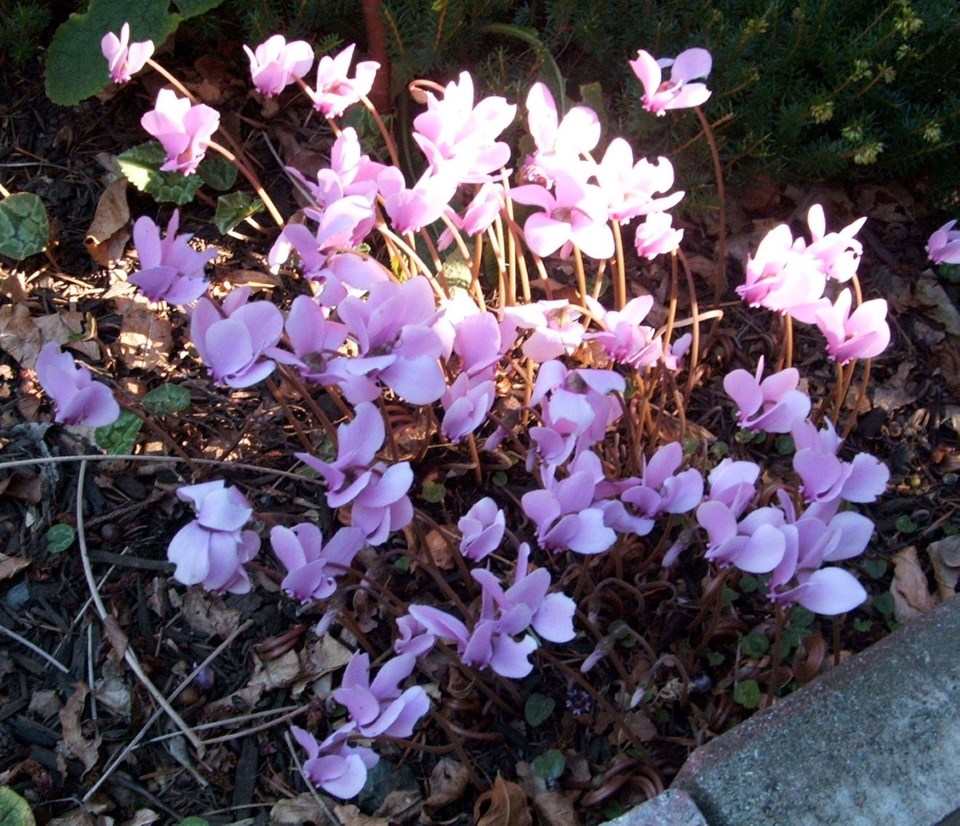Dear Helen: Last month I came across two large swaths of cyclamen in bloom. The sight has inspired me to create a similar display in our garden. How do I proceed with this project?
J.M.
The plantings you saw were probably Cyclamen hederifolium (ivy-leaved cyclamen). The tubers and young plants of this hardy tuberous perennial are also sold as C. neapolitanum.
A few phone calls to your local garden centres may unearth a source, though the tubers are more often available in the spring. Another source is Fraser’s Thimble Farms on Salt Spring Island. They ship in the fall and list three forms of the species. Visit thimblefarms.com, look at the C. hederifolium listings and then go to Mail Order Info.
These little cyclamens naturalize easily to make a beautiful ground cover throughout the winter. The foliage dies down in the warmth of spring and masses of little blooms emerge to create a floral carpet in late summer and early fall. The leaves are artistically marbled in silver. The flowers are most commonly pink, but there is a white-flowering form.
Almost every time I mention these hardy cyclamens in a column I receive notes from gardeners lamenting the plants’ extreme vigour and spreading habit in our climate. They do spread easily from seed. I’ve never been anything but pleased at this habit, but it does annoy some people.
Dear Helen: We have three astilbe plants that have not done well in the hot sun of our south-facing back garden. We’d like to move them to a less sunny location. Can we do that now?
L.S.
Astilbe, also known as false spirea, are prized for their feathery floral plumes. These perennials can be planted in fall or spring. They require a partly shaded location and a rich, moist soil. To keep them at their showiest best, the bigger (taller) varieties in particular should be dug up and divided every two or three years.
Dear Helen: A person working in a local garden centre has suggested that I discontinue my practice of planting fall rye as a winter cover crop because the rye encourages wireworm infestations in the soil. Do you agree?
E.T.
Wireworms are the larvae of adult “click” beetles, which lay eggs in the spring in grassy areas. Fall rye is a grassy plant that could attract the egg laying. Avoid using fall rye especially where wireworms have been a serious problem. Instead, cover empty plots with small or chopped leaves or some other organic soil cover.
Dear Helen: I’ve been given an evergreen azalea that is still in its original nursery pot. Should I plant it now in the garden or wait until spring? I have a sunny spot picked out for the plant.
L.M.
Evergreen azaleas can be planted in the spring or fall, but since the plant is still in the pot it was sold in, it will probably over-winter better if transplanted into the garden now. Keep in mind, however, that these azaleas are tricky to grow well in areas exposed to hot sun, which they can tolerate only if the soil is acidic, very well plumped with moisture-retaining organic matter, and kept consistently moist. Since our summers are becoming hotter, you may want to assess the site again before installing an evergreen azalea in it.
GARDEN EVENTS
Floral arts. The Mid Island Floral Art Club will meet this afternoon at 2 in St. Stephen’s Church Hall, 150 Village Way in Qualicum Beach. Theme for the afternoon: “Let’s make transparent designs together.” More information at 250-752-1858.
Best heather companions. The 91ԭ�� Island Heather Society offers a free presentation on Saturday, 2 p.m., featuring Hector Bussiere, a well-known local gardening expert, who will discuss twenty of the best perennials, shrubs and small trees to plant as companions for your heathers. All are welcome. Hector will show live samples of the plants he is discussing and he encourages questions. Prior to the meeting, a handout of the plants to be discussed will be available on the society’s website at .
Free nursery courses. Dinter Nursery, 2205 Phipps Rd. in Duncan, offers the following free, drop-in classes on Saturday.
• Cuttings and Plant Propagation at 10 a.m. Learn how to duplicate your favourite plants as they wind down.
• Bonsai Demo and Workshop from 12 to 2 p.m. Drop in to meet members of the Cowichan Valley Bonsai Club. See how a bonsai is created, or bring your bonsai in for an assessment.



